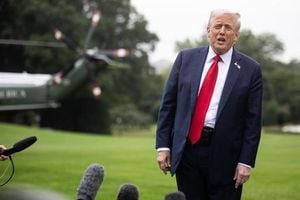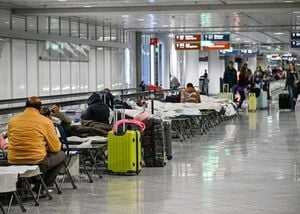As autumn 2025 unfolds, the war in Ukraine has entered a new, complex phase—one marked by shifting frontlines, high-stakes diplomacy, and a scramble for energy dominance across Europe. The past week, in particular, has seen a flurry of proposals, warnings, and power plays, all set against the backdrop of Russia’s grinding military push and the West’s search for leverage.
Kyiv’s latest gambit is as ambitious as it is urgent: Ukraine is pitching Washington on a plan to help the United States replace Russia as Europe’s primary oil supplier, leveraging Ukraine’s extensive gas and oil infrastructure. According to The New York Post, Ukrainian Energy Minister Svitlana Grynchuk described Ukraine’s energy network as a “key part of European energy security,” noting, “The US and other international partners could use this infrastructure for ensuring European energy security by supplying it and also the storage potential of gas and oil in Ukraine.” She emphasized that Ukraine boasts the most liquid natural gas storage in all of Europe—a strategic asset in the continent’s ongoing energy tug-of-war.
The proposal, which remains in its infancy, was floated by Andriy Yermak, President Volodymyr Zelenskyy’s top advisor, during a sideline conversation with US Ambassador to the United Nations Mike Waltz at the recent UN General Assembly. Yermak recounted, “I asked him to introduce me to your Secretary of Energy. I asked him that please, as soon as possible, please arrange the meetings [between US Energy Secretary Chris Wright and Grynchuk,] and we can come.” The idea: use Ukraine’s pipelines to funnel American oil into Europe, thereby helping the continent wean itself from Russian energy and, as Yermak put it, “work together, because Ukraine is the responsible partner [over Russia].”
This isn’t just about pipelines and profits. The stakes are existential for Ukraine—and deeply consequential for Europe. As Russian President Vladimir Putin’s war machine continues its slow, brutal advance, energy revenues remain Moscow’s economic lifeline. President Trump, echoing this view, has spent weeks urging European nations to divest from Russian oil, even directly pressuring Turkey’s President Recep Tayyip Erdogan in a recent Oval Office meeting. “I’d like to have him stop buying any oil from Russia while Russia continues its rampage against Ukraine,” Trump said, according to The New York Post. “[Moscow has] lost millions of lives already, and for what? You know, for what? Disgraceful.”
Yet, Europe’s energy landscape is stubbornly complex. Slovakia and Hungary continue to resist calls to abandon Russian oil, while non-EU states like Turkey and Serbia maintain their own, often pragmatic, ties to Moscow. According to The New York Post, Zelenskyy has personally lobbied Slovakia’s Prime Minister Robert Fico for alternatives, and Yermak remains hopeful: “We are ready to work together with European partners, if we can help and participate. And we have heard from Prime Minister [Fico] that he is open to find the alternative.” Hungary, meanwhile, remains loyal to Russian oil for now, but Yermak believes Trump could sway Budapest given America’s outsized influence.
Serbia, for its part, is cautiously exploring diversification. Foreign Minister Marko Đurić told The New York Post that while Serbia is interested in US energy, it isn’t ready to sever its Russian ties, especially as the Kremlin owns a majority stake in Serbia’s Naftna Industrija Srbije (NIS) oil and gas company. Instead, Belgrade is seeking further delays on sanctions targeting NIS, citing the need for “a secure and reliable energy supply for our citizens and to sustain the growth of our economy.” US sanctions on Russia’s oil sector, first imposed in January, are now set to take effect on October 8, 2025.
Meanwhile, the war’s violence and unpredictability persist. According to Al Jazeera, Russia seized 447 square kilometers of Ukrainian territory in September—a slower pace than July’s 634 square kilometers, but a reminder that the front is far from static. Russian shelling near Slavutych recently cut external power to the decommissioned Chornobyl power plant, prompting President Zelenskyy to accuse Moscow of trying to orchestrate a nuclear incident. Over 3,000 people in the Chernihiv region lost power, underscoring the civilian toll of the conflict. Emergency crews, as reported by The Guardian, have been working around the clock to restore electricity, with full restoration in parts of Sumy and ongoing repairs elsewhere.
Diplomatic efforts are no less intense. On October 2, 2025, Zelenskyy met with 50 heads of state and EU leaders in Copenhagen, urging unity against Russian aggression. He warned that recent drone incursions—some linked to Russian shadow fleets and mysterious flights over Denmark and the Baltics—signaled Moscow’s intent to “break the west and Europe.” In his words: “If the Russians dare to launch drones against Poland, or violate the airspace of northern European countries, it means this can happen anywhere.”
The security challenge is acute. Danish Prime Minister Mette Frederiksen, addressing EU leaders, declared, “Europe is facing the greatest security challenge since the end of World War II.” The Group of Seven has vowed to increase pressure on countries buying Russian oil or helping Moscow circumvent restrictions, and European leaders are considering using frozen Russian assets to fund a €140 billion ($164 billion) loan to Kyiv.
On the military front, the US is stepping up its support for Ukraine in new ways. According to The Wall Street Journal and The Guardian, Washington will now supply Kyiv with intelligence on long-range energy infrastructure targets deep inside Russia—a significant policy shift by the Trump administration. NATO allies have been asked to follow suit. However, despite speculation, US officials told Reuters that sending Tomahawk missiles to Ukraine is unlikely due to current commitments; instead, shorter-range alternatives may be considered. Russian President Vladimir Putin has warned that such moves would trigger “a whole new level of escalation,” but also downplayed Western fears of a direct Russian attack on NATO as “nonsense.”
Amidst the high-level maneuvering, the human cost of war remains ever-present. On October 2, 2025, Russia and Ukraine exchanged hundreds of prisoners of war—185 military personnel and 20 civilians returned to Ukraine, most held since 2022. According to Zelenskyy, more than 7,000 Ukrainians have been freed since the war began. In Russia, the crackdown on dissent continues; Maxim Kruglov, deputy leader of the liberal Yabloko party, was charged with spreading “lies” about the Russian army and faces up to 10 years in jail, as reported by The Guardian.
As the world watches, the battle for Ukraine is now as much about energy, alliances, and information as it is about territory. Whether Kyiv’s bold proposals and the West’s evolving support can alter the war’s trajectory remains to be seen. But one thing is clear: the struggle for Ukraine’s future—and Europe’s security—is far from over.




